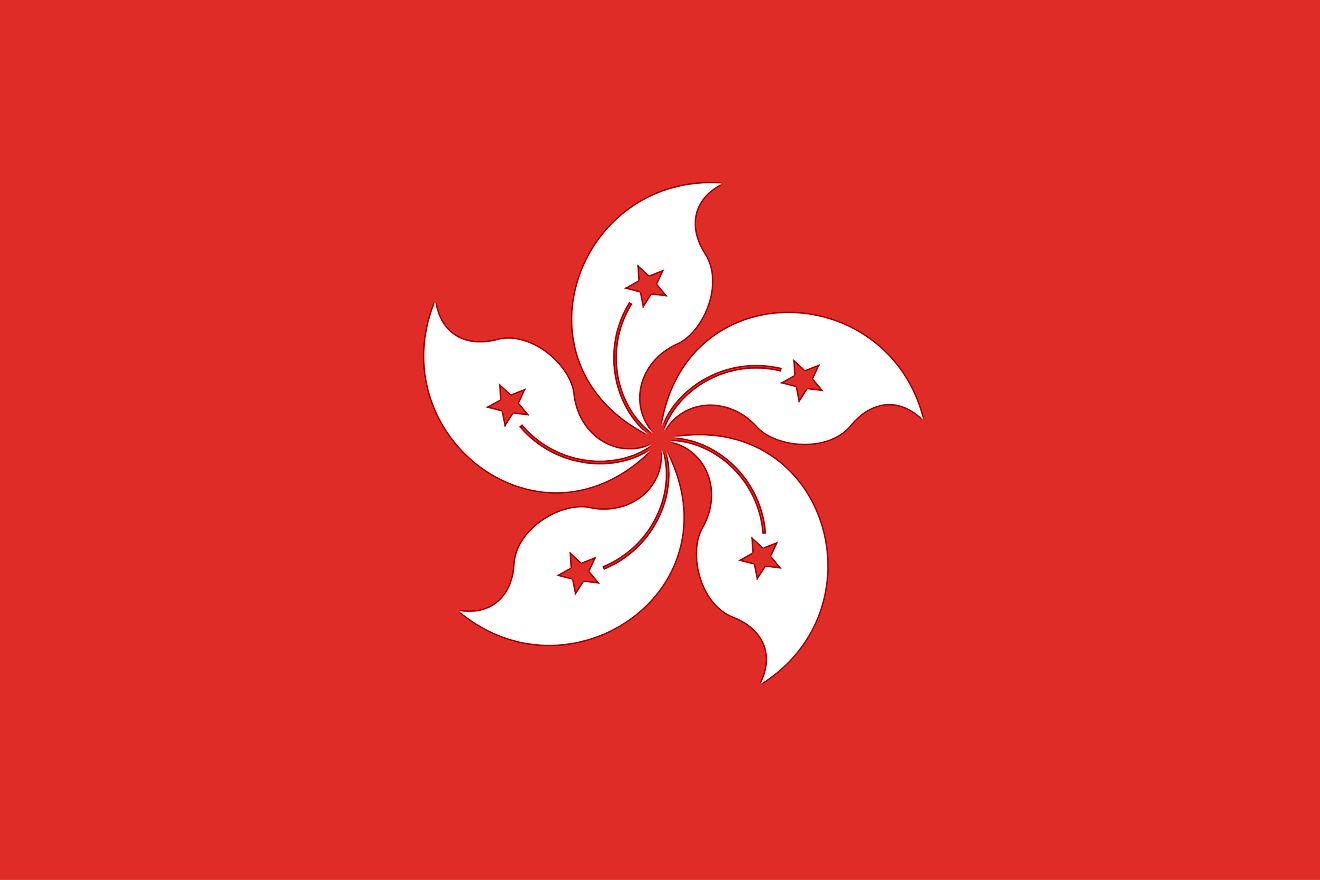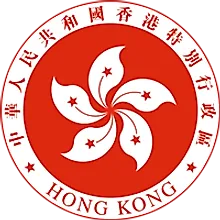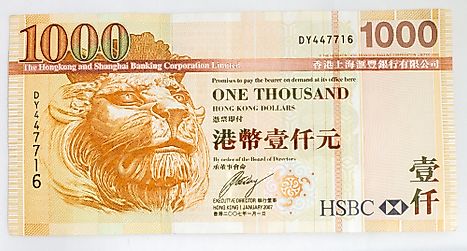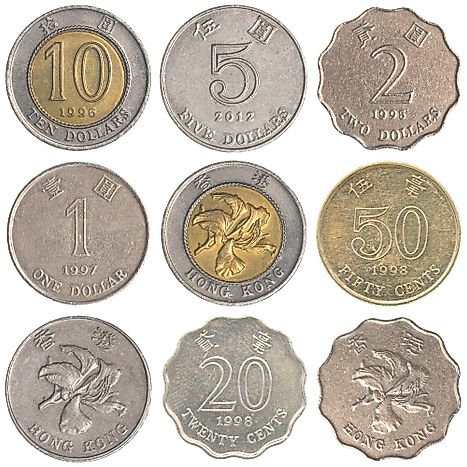Flags, Symbols, & Currencies of Hong Kong

Although Hong Kong is a special administrative region of China, it has a regional flag. However, the regional flag is often displayed alongside the national flag (flag of the China). When the Hong Kong flag is flown alongside the national flag, the regional flag must be on the left of the national flag. The regional flag must also be shorter and smaler in size than the national flag. The flag of Hong Kong was approved in April 1990 but has been used since 1997.
The flag of Hong Kong is red with a stylized, white, five-petal Bauhinia flower in the center. Each petal contains a small, red, five-pointed star in its middle. The red color is the same as that on the Chinese flag and represents the motherland. In China, the red color is a festive color, symbolizing nationalism and celebration. The color was included on the flag of Hong Kong to signify the link between China and Hong Kong. The fragrant Bauhinia - developed in Hong Kong in the late 19th century - is the region's symbol. The five stars echo those on the flag of China, symbolizing that all residents of Hong Kong are part of motherland China.The national flag of Hong Kong has a height to length proportion of 2:3.
History of the Flag of Hong Kong
Before Hong Kong became part of the United Kingdom, it was governed by China and flew the Chinese flag at the time. Hong Kong was part of the Qui Empire, which did not have a flag until 1862. From 1862, the empire used a flag which featured an azure on a yellow background and a red flaming pearl on the top left corner. When the crown colony of Hong Kong was established, Hong Kong adopted the colonial Blue ensign. The Union Jack was later defaced with the region's seal. The colonial flag was used until 1997 and replaced with the current flag of Hong Kong.
Symbols of Hong Kong
Regional Coat of Arms of Hong Kong

The Regional Emblem of the Hong Kong Special Administrative Region of the People's Republic of China was adopted along with the flag in 1997. The emblem is round-shaped and features elements from the regional flag, and bears the region's official name in Chinese and English on the outer white ring. The red inner ring bears the five-star shaped white petal (bauhinia) with five-pointed red stars. The coat of arms are mainly used in government offices and border checkpoints.
National Anthem
- Anthem Title: March of the Volunteers
- Music composer: Nie Er
- Lyricist: Tian Han
- Date of Adoption: 1997
"March of the Volunteers" Iis the national anthem of China and and its special administrative regions of Macau and Hong Kong. The lyrics were written by Tian Han, Japanese-eucated poet, in 1934. Its composition was done by Nie Er in 1935. It was adopted as Hong Kong's anthem on July 1, 1997, the day Britain handed over Hong Kong to PRC.
义勇军进行曲 義勇軍進行曲 (Chinese)
各(Gè)民族(mínzú)英雄(yīngxióng)的(de)人民(rénmín!)!
伟大(Wěidà)的(de)(gòngchǎndǎng,),领导(lǐngdǎo)我们(wǒmen)继续(jìxù)长征(chángzhēng!)!
万众一心(Wànzhòngyīxīn)奔(bēn)向(xiàng)共产主义(gòngchǎnzhǔyì)明天(míngtiān!)!
建设(Jiànshè)(zǔguó,),保卫(bǎowèi)(zǔguó,),英勇地(yīngyǒngde)斗争(dòuzhēng.)
前进(Qiánjìn!)!前进(Qiánjìn!)!前进(Qiánjìn!)!
我们(Wǒmen)(qiānqiūwàndài,),
高举(Gāojǔ)毛泽东(Máo Zédōng)(qízhì,), 前进(qiánjìn!)!
高举(Gāojǔ)毛泽东(Máo Zédōng)(qízhì,), 前进(qiánjìn!)!
前进(Qiánjìn!)! 前进(Qiánjìn!)! 进(Jìn!)!
March of the Volunteers
March on! Heroes of every race!
The great Communist Party leads us in continuing the Long March!
Millions with but one heart toward a communist tomorrow
Bravely struggle to develop and protect the motherland.
March on! March on, March on!
We will for many generations
Raise high Mao Zedong's banner! March on!
Raise high Mao Zedong's banner! March on!
March on! March on! On!
The Currency of Hong Kong is the Hong Kong Dollar
Although Hong Kong is a special administrative region of China, it uses Hong Kong dollar as the official currency instead of renminbi. The region's central bank, Hong Kong Monetary Authority, is responsible for the Hong Kong's currency. However, the authority has licensed three banks to issue banknotes for circulation. The Hong Kong dollar is symbolized by HK$ and coded as HKD. It is one of the ten most-traded currencies in the world.
Coins
The Hong Kong dollar coins come in several denominations, including 10¢, 20¢, 50¢, $1, $2, $5, and $10. During the colonial period, the British monarch's effigy embosed on the coins. However, the effigy was done away with in 1992. The 1993 to 1994 coin series depicted bauhinia flower. Although coins bearing the image of Queen Elizabeth II are no longer minted, they are still legal tender.
Banknotes
Three commercial banks are licensed to mint backnotes in Hong Kong. These banks are; Bank of China, Standard Chartered Bank, and The Hongkong and Shanghai Banking Corporation Limited. These banks issue banknotes in the denominations of $10, $20, $50, $100, $500, and $1,000. The banknotes are issued in different colors, including gold (1000), brown (500), red (100), green (50), and blue (20).
Commemorative Coin
In 1997, Hong Kong issued a commemorative coin to commemorate its sovereignty from the British. The commemorative coins depicted Hong Kong's landmarks, Chinese culture, and 19 and 97.
Historical Currencies of Hong Kong
When Hong Kong was established in 1841, the region had no local currency. Instead, several currencies were in circulation, including reales, rupees, and Chinese cash coins. In 1845, the Spanish reales were adopted as region's legal tender. When the British established a colony over Hong Kong, they tried to introduce sterling coinage in vain. However, they managed to begin minting Hong Kong silver dollar in 1866. The first dollar denominated banknotes began circulating in Hong Kong in the 1860s.














